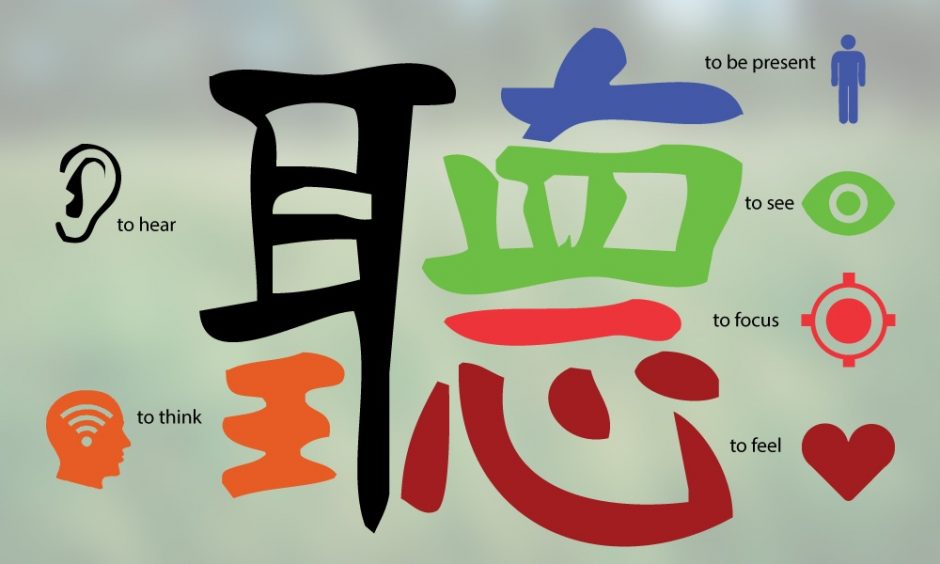The second half of the course reading ‘Coaching Skills for Leaders in the Workplace’ – Jackie Arnold has already highlighted a line of personal enquiry – Clean Language. Which connects with a second area of interest, supporting teacher professional development and ‘The Discipline of Noticing,’ – an approach towards noticing possibilities for acting differently in the moment proposed by John Mason. (What I did not know at the start of draft this post, was that Clean Language also has links with complex adaptive systems and therefore Complexity Theory. As well as emergent behaviour).
Clean Language
Clean Language aligns within phenomenological methodology (a qualitative research approach that asks what it is like to consciously experience a particular situation) which addresses widely recognised difficulties in the process of exploring and explicating a person’s self. Developed by counselling psychologist David Grove, it makes use of only the most basic elements of human perception or lived: space, category, attribution and intention.
Using Clean Language aims to minimise undesired influence and unintended bias of the Coach, as well at the introduction of the Coaches metaphors and constructs. From what I understand, it is similar to the practice of ‘bracketing’ used in other areas phenomenological research reported as the attempt to “suspend prior knowledge or belief about the phenomenon under study.” Clean Language therefore offers an alternative to the structured or semi-structured conversation, (that I am familiar with) in that it is more attuned to the Coachee rather than following a set path for all. That said, it is most certainly not fluid, with strict protocol to adhere to.
Why metaphors? Metaphor – derived from the Greek ‘amphora’ or storage container for transporting valuable goods. Metaphors are fundamental to the process of human thinking. We use metaphors to transport or condense meaning from one experience to another. They exist in a “mindspace” – a stage in the theatre of our mind where the play of consciousness is enacted and they are far more prevalent than I realised.*
Generally speaking, metaphors operate at an unconscious level, both descriptive and proscriptive, and by paying attention to them, coachees can gain access to a deeper level of understanding of themselves and their conscious experience: the structure of their thinking; the patterns that run their lives; their personal truths and underpinning values.
A large part of self-understanding is the search for appropriate personal metaphors that make sense of our lives.
Linguists George Lakoff and Mark Johnson, 1980
In ways that we don’t necessarily appreciate, our inner states are the result of our outer circumstances.
Malcolm Gladwell
At this point is worth underlining that metaphors are not transferable. They are a very personal interpretation of a phenomenon. They need unpacking and explaining before they can be exchanged.
The combination of Clean Language with Coachee-generated metaphors (and the strict absence of Coach metaphors and constructs) helps make the Coachee aware of how their own assumptions, attributions and intentions that influences the systems in which they live and work. Only using the words and metaphors offered by the Coachee, avoids Coach contamination, and also encourages the Coachee to reflect and gain greater clarity of their own thoughts (importantly, through their own language).
Asking Clean Language Questions
‘Clean’ refers to the use of a coachee’s own words (and metaphors) to direct their attention to some aspect of their own experience (whilst also harvesting information). Asking these questions in the right context often results in interesting new insights or the recognition of new possibilities. Already, I am thinking these skills would be useful to pastoral leaders in schools, exploring the ‘what,’ ‘how’ and ‘why’ “such and such” an incident occurred. Or for teachers receiving sensitive information, for example, in the case of a safeguarding disclosure, gathering a ‘clean’ outline of the situation.
In cleansing the questions four points are shared.
“(And) what kind of X (is that X)?”
Grove dropped most verbs and pronouns, he directs the coachee’s attention, he introduced “that,” he framed all his questions in the present tense and prefaced the questions with “And,” to hold the coachee in the experience.
The exception, where the question contains the verb ‘to be,’ it is used to hold time still and is mostly used for developing Coachee perceptions.
Developing questions
- “(And) what kind of X (is that X)?”
- “(And) is there anything else about X?”
- “(And) where is X? or (And) whereabouts is X?”
Sequencing and source questions
- “(And) when X, what happens to X?”
- “(And) what happens just before X?
- “(And) where could X come from?”
Intentions questions
“(And) that’s X like what?” (this gets you the metaphor that you can then explore)
The first two questions, are the most commonly used and as a general guide, account for around nearly half of the questions asked in a typical Clean Language session. For example, a coachee may say “I need to show more authority in these situations,” and you respond “And what kind of authority is that?” The Coachee may respond with “More in charge, less diplomatic.” And respond with “And what kind of ‘in charge’ is that?”
“And when you’re showing you are ‘in charge’, that’s like… what?” Now I am not experienced in using Clean Language, however I get the sense that this would have been a suitable opportunity for the Coach to encourage the coachee to offer a metaphor or outline of the optimal state. The Coach going on to support the coachee in exploring the metaphor or outline, using more Clean Language questions.
As Arnold point out, “With clean language it is easier to stay out of the clients world.” p142. Talking with Jane Suter (Red Tiger Consultancy) we discussed that fact that Clean Language questions sound
grammatically awkward. It’s true, they do, however you need to be considering the questions as a Coachee receiving and responding, not as a Coach, asking. When I was being coached, I was not aware of Clean Language, I didn’t hear the awkwardness, I was too busy trying to compose my thoughts and respond. In truth, the questions auditorily sounded and felt remarkably… sensible. The solutions arising from the resynthesis of one’s thinking.
Of course, we read Clean Language and immediately focus on the words. However, Clean – purports to all aspects of the session, your own thoughts, gaze, posture and gestures. (I have just learnt that this is referred to as behaving cleanly).
Clean Language process is an area within Coaching, I plan to explore further in the coming weeks. More recent references highlight the contribution of James Lawley, Penny Tompkins and Judy Rees.
Clean Language provides space for some to explore their own thinking.
Olaf Lewitz – The True Artist
Complexity
Clean Language connects with Complexity Theory in that it recognises that complex-adaptive systems (coachees) learn through embodied activity, feedback and iteration. The results are emergent and unpredictable,from that of the underlying rules or initial conditions.
The Discipline of Noticing
Clean Language connects with The Discipline of Noticing because before the coachee can think and reflect, one would suggest they must first notice. For Mason, noticing extends to marking and through to recording. Mason suggests recording significant events through writing descriptive, brief-but vivid accounts,
If we want to be in a position to analyse some event, some situation, then we must first be clear on what that event or situation consists of, as impartially as possible.
(Mason, 2002, p.39)
Mason describes this as accounting-of. An account-of describes events as objectively as possible.
Mason, J. (2002) The Discipline of Noticing: Researching Your Own Practice, London: Routledge
Metaphors* The exact figure is obfuscated by the difficulty of agreeing on what counts as a metaphor.

